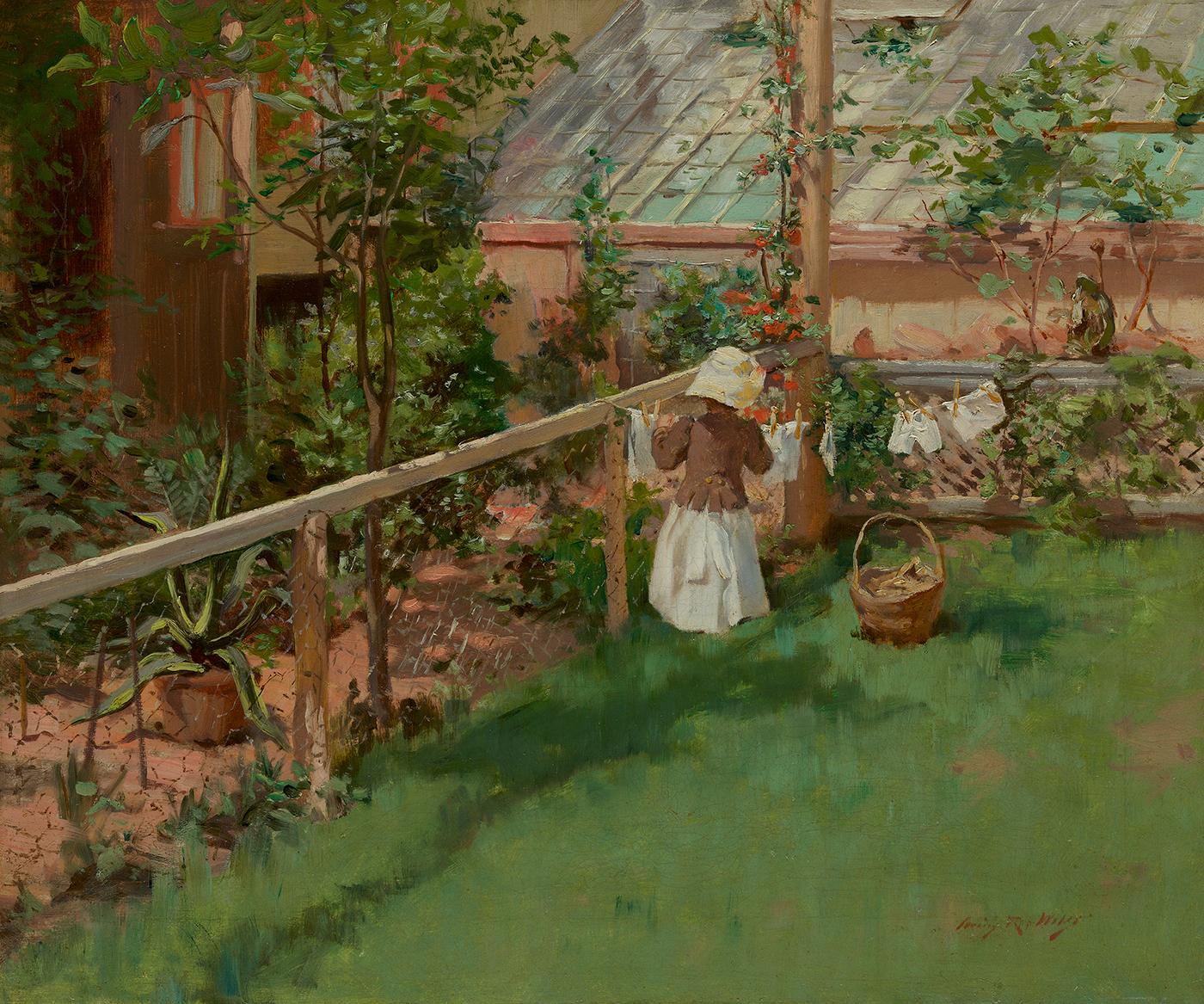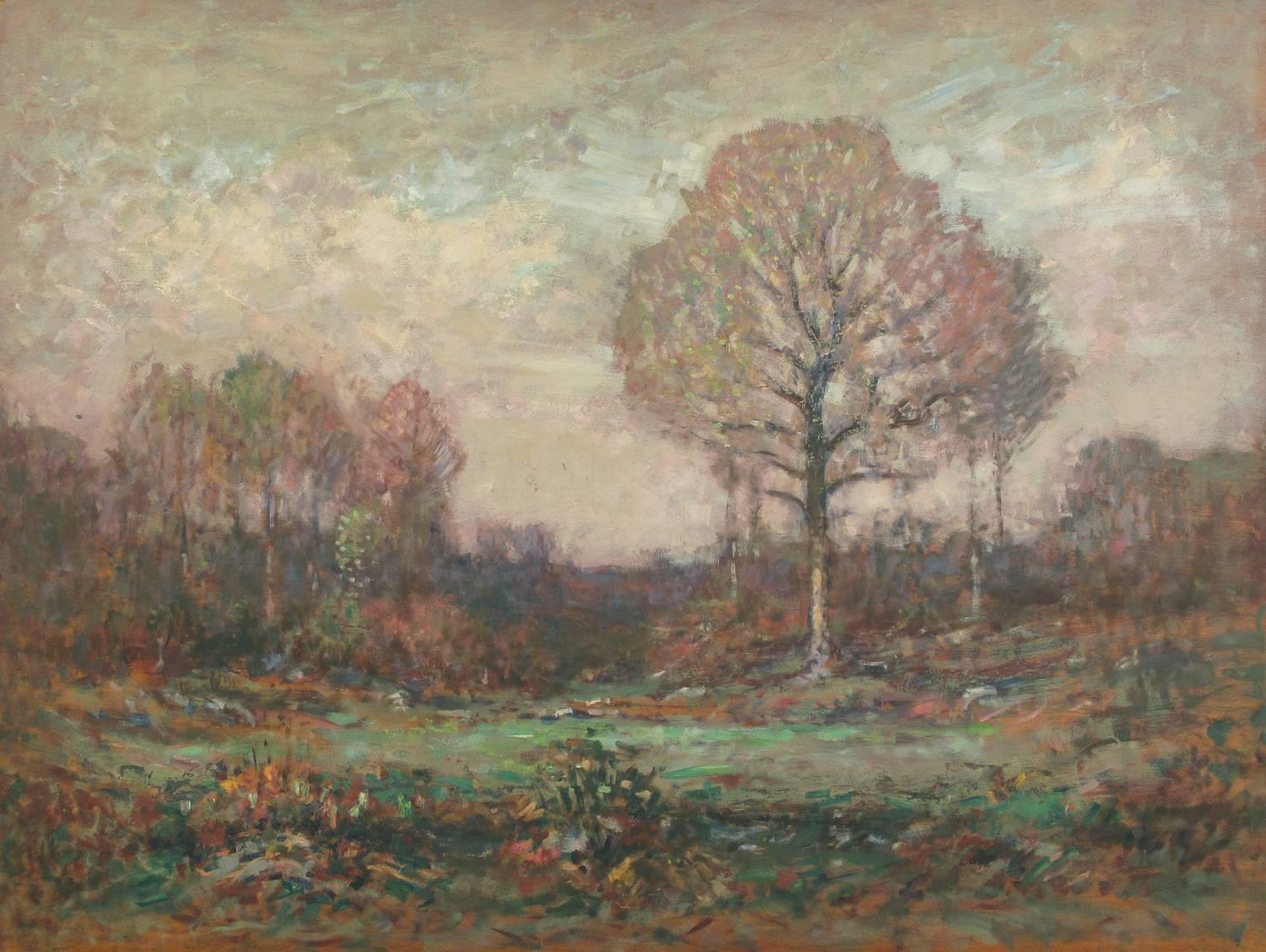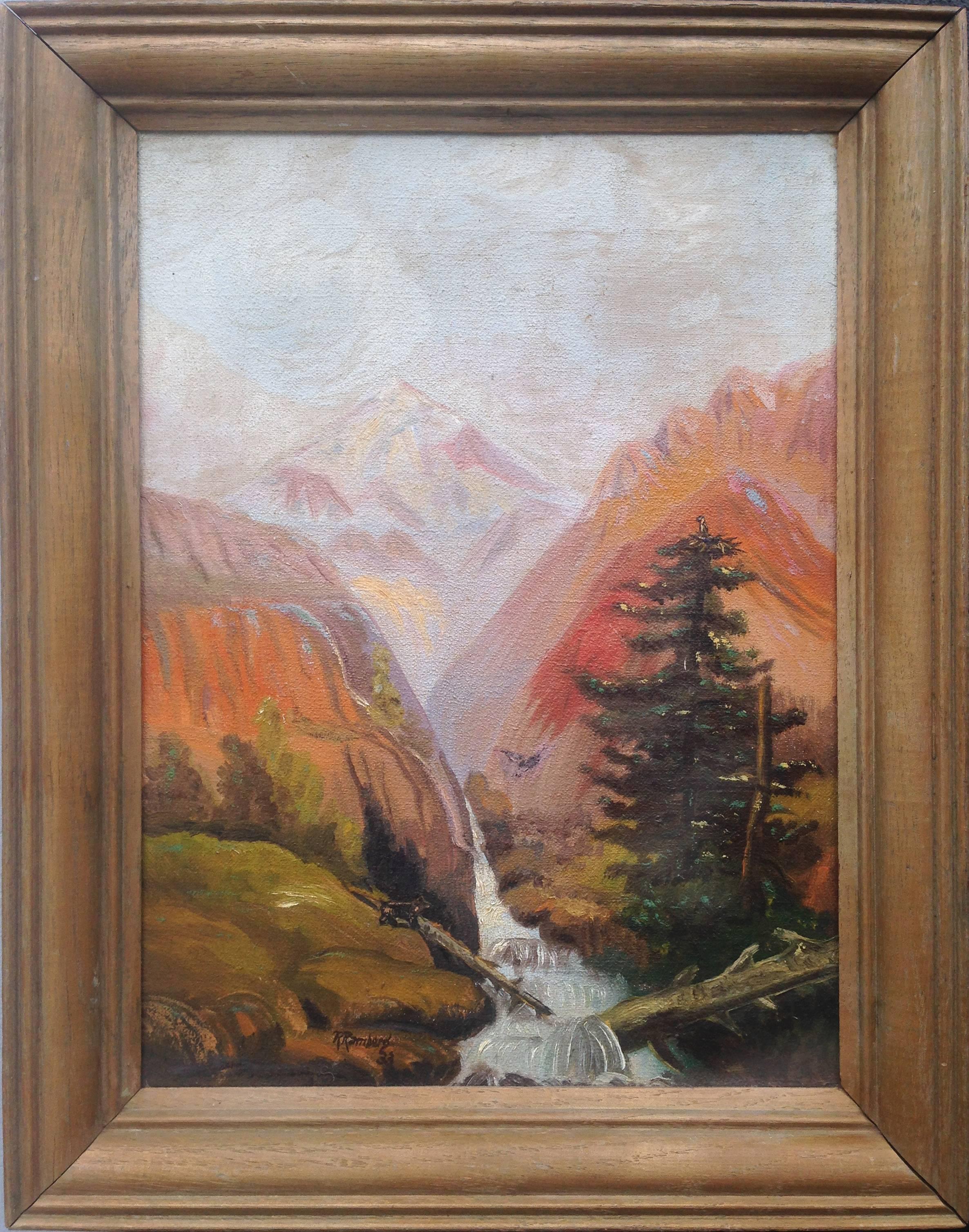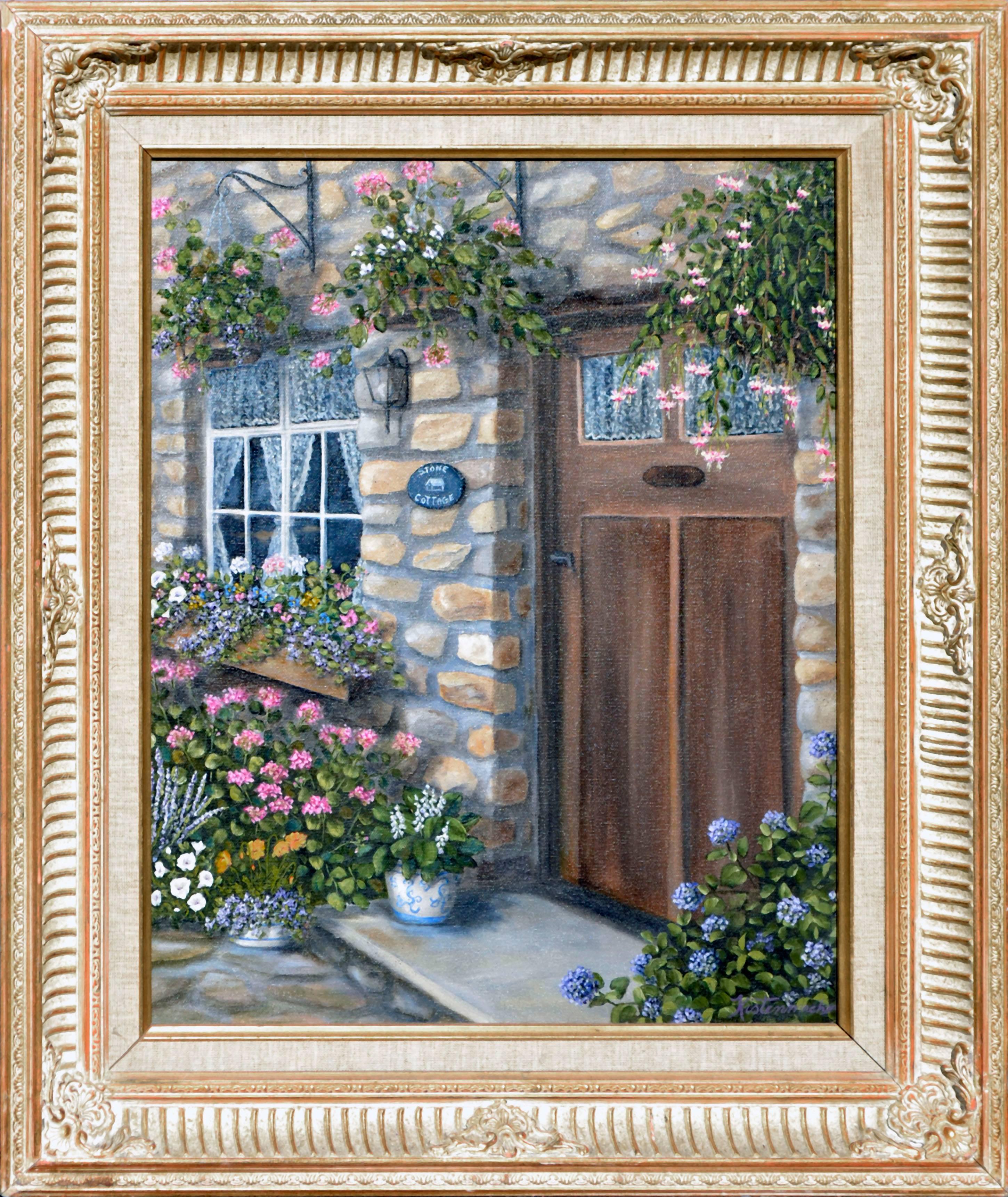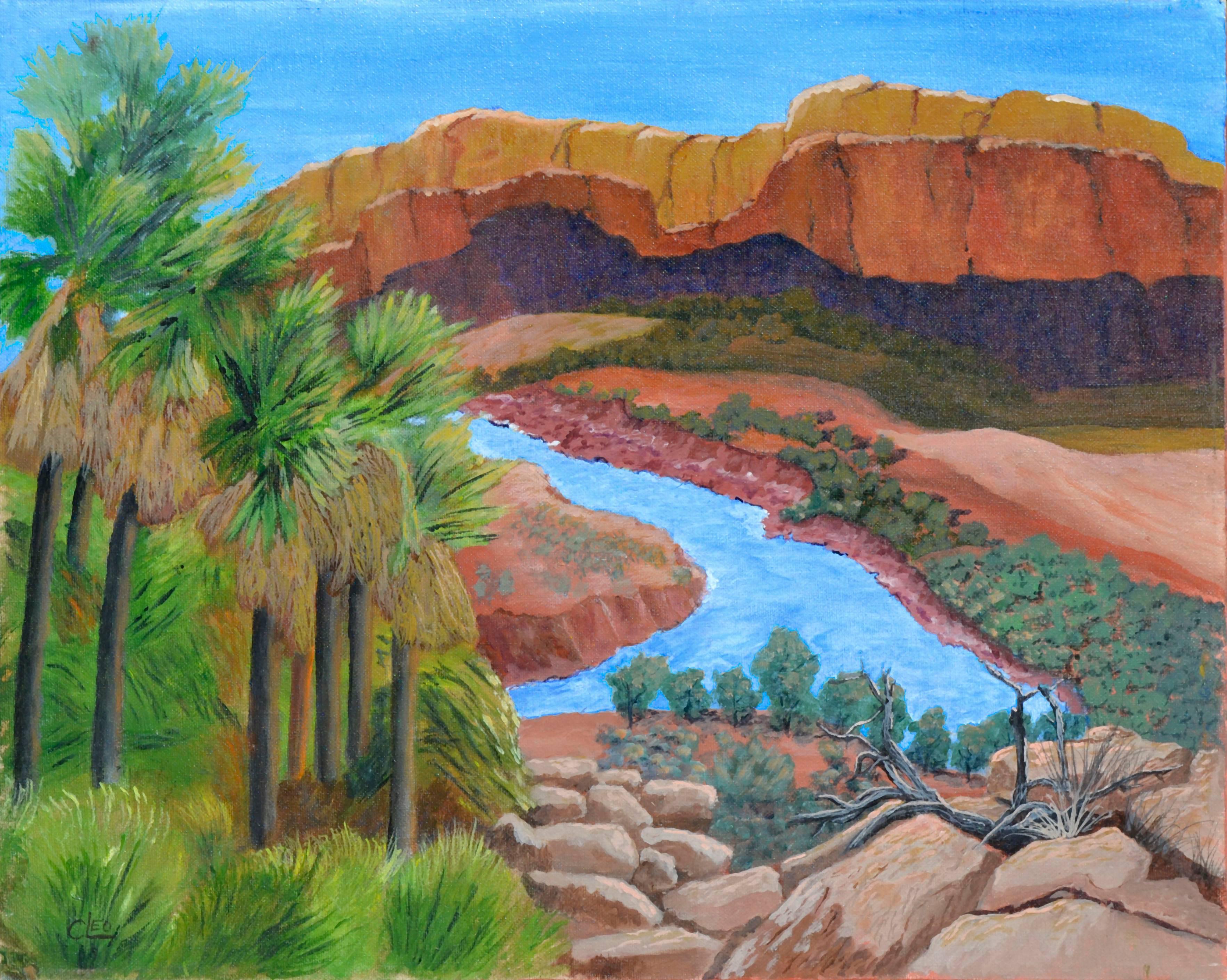Items Similar to "June Afternoon"
Want more images or videos?
Request additional images or videos from the seller
1 of 6
John Fulton Folinsbee"June Afternoon"c. 1920
c. 1920
About the Item
Jim's of Lambertville Fine Art Gallery is proud to present this piece by John Fulton Folinsbee (1892 - 1972).
One of the finest painters to embark upon the New Hope Art Colony, John Folinsbee, did so in 1916. Born in Buffalo, New York, he was an active young man who enjoyed playing sports and swimming like most. In the summer of 1906, while on a family vacation in Sea Cliff, Long Island, Folinsbee (nicknamed Jack) felt extremely tired while swimming in the bay. Barely making it back to shore, he collapsed stricken with polio. Almost taking his life, the attack left his legs paralyzed and right arm badly weakened. Polio would confine him to a wheelchair for the rest of his life. Making bad times even worse, one week later Jack’s older brother was killed in a diving accident. Faced with these adversities, Folinsbee made the best of his situation.
Determined not to let this handicap keep him down, he enrolled at the Art Students League in Woodstock, New York, under the tutelage of Birge Harrison and John F. Carlson in 1912. These two men would prove to be powerful influences in the development of his career. It was there that Folinsbee met his lifelong friend and the best man in his wedding, fellow artist, Harry Leith-Ross.
Folinsbee married Ruth Baldwin in 1914, and two years later, upon the suggestion of Birge Harrison, the couple moved permanently to New Hope. Jack and Ruth had two daughters together named Beth and Joan.
Folinsbee said of Harrison, “I perhaps owe more to Mr. Harrison in the development of my work and the influence of his friendship on my character than to any other man”, and of John F. Carlson, “I am very grateful of the instruction given to me by John Carlson. I needed it”.
In 1924 Folinsbee bought a piece of property along the Delaware River on Main Street in New Hope where he had a home designed and built by artist and architect, Morgan Colt. This remained Folinsbee’s home and studio for the rest of his life.
Folinsbee, early in his career (1912-24) painted in a heavy impressionist style with tightly applied broken brush strokes similar in technique to the works of Childe Hassam. In the mid and later 1920s and into the 1930s, his brush strokes broadened. Folinsbee’s figurative works from this period have a strong Ashcan feeling. In the late 1930s and into the 1940s, his strokes became even broader and eventually he employed the use of a palette knife for the application of paint.
In the summer, Folinsbee often traveled to Maine with his family where he would load equipment into a small boat and head out to paint. Folinsbee learned to adapt to almost any situation, not allowing his disability to hold him back. There are few in the field of twentieth century American painting that rival the ability of John Folinsbee. He was truly one of New Hope’s finest artists.
Folinsbee’s work has been represented in numerous important national exhibitions from 1913-1970 and was the recipient of many medals, prizes and awards. His work is in the permanent collections of the Pennsylvania Academy of the Fine Arts, the Rhode Island School of Design, the National Academy of Design, the Phillips Collection (Washington), the Corcoran Gallery of Art, the Museum of Fine Arts in Houston, the New Jersey State Museum, Princeton University Art Museum, the Philadelphia Art Club, the Reading Art Museum, the National Art Club and the James A. Michener Art Museum, among others.
- Creator:John Fulton Folinsbee (1892-1972, American)
- Creation Year:c. 1920
- Dimensions:Height: 16 in (40.64 cm)Width: 19 in (48.26 cm)
- More Editions & Sizes:Frame Size 23" x 27" x 3"Price: $74,375
- Medium:
- Movement & Style:
- Period:
- Condition:
- Gallery Location:Lambertville, NJ
- Reference Number:
About the Seller
5.0
Vetted Seller
These experienced sellers undergo a comprehensive evaluation by our team of in-house experts.
Established in 1997
1stDibs seller since 2014
36 sales on 1stDibs
Typical response time: 6 hours
- ShippingRetrieving quote...Ships From: Lambertville, NJ
- Return PolicyThis item cannot be returned.
More From This SellerView All
- "The Canal"By Edward Willis RedfieldLocated in Lambertville, NJJim’s of Lambertville is proud to offer this artwork. Signed lower left. Complemented by a hand carved and gilt frame. Illustrated in "Edward Redfield: Just Values and Fine Seeing" by Constance Kimmerle and the Pennsylvania Academy of the Fine Arts's Exhibition of Paintings by Edward Redfield (April 17 to May 16, 1909) brochure Edward Willis Redfield (1869 - 1965) Edward W. Redfield was born in Bridgeville, Delaware, moving to Philadelphia as a young child. Determined to be an artist from an early age, he studied at the Spring Garden Institute and the Franklin Institute before entering the Pennsylvania Academy from 1887 to 1889, where he studied under Thomas Anshutz, James Kelly, and Thomas Hovenden. Along with his friend and fellow artist, Robert Henri, he traveled abroad in 1889 and studied at the Academie Julian in Paris under William Bouguereau and Tony Robert-Fleury. While in France, Redfield met Elise Deligant, the daughter of an innkeeper, and married in London in 1893. Upon his return to the United States, Redfield and his wife settled in Glenside, Pennsylvania. He remained there until 1898, at which time he moved his family to Center Bridge, a town several miles north of New Hope along the Delaware River. Redfield painted prolifically in the 1890s but it was not until the beginning of the twentieth century that he would develop the bold impressionist style that defined his career. As Redfield’s international reputation spread, many young artists gravitated to New Hope as he was a great inspiration and an iconic role model. Edward Redfield remained in Center Bridge throughout his long life, fathering his six children there. Around 1905 and 1906, Redfield’s style was coming into its own, employing thick vigorous brush strokes tightly woven and layered with a multitude of colors. These large plein-air canvases define the essence of Pennsylvania Impressionism. By 1907, Redfield had perfected his craft and, from this point forward, was creating some of his finest work. Redfield would once again return to France where he painted a small but important body of work between 1907 and 1908. While there, he received an Honorable Mention from the Paris Salon for one of these canvases. In 1910 he was awarded a Gold Medal at the prestigious Buenos Aires Exposition and at the Panama-Pacific Exposition of 1915 in San Francisco, an entire gallery was dedicated for twenty-one of his paintings. Since Redfield painted for Exhibition with the intent to win medals, his best effort often went into his larger paintings. Although he also painted many fine smaller pictures, virtually all of his works were of major award-winning canvas sizes of 38x50 or 50x56 inches. If one were to assign a period of Redfield’s work that was representative of his “best period”, it would have to be from 1907 to 1925. Although he was capable of creating masterpieces though the late 1940s, his style fully matured by 1907 and most work from then through the early twenties was of consistently high quality. In the later 1920s and through the 1930s and 1940s, he was like most other great artists, creating some paintings that were superb examples and others that were of more ordinary quality. Redfield earned an international reputation at a young age, known for accurately recording nature with his canvases and painting virtually all of his work outdoors; Redfield was one of a rare breed. He was regarded as the pioneer of impressionist winter landscape painting in America, having few if any equals. Redfield spent summers in Maine, first at Boothbay Harbor and beginning in the 1920s, on Monhegan Island. There he painted colorful marine and coastal scenes as well as the island’s landscape and fishing shacks. He remained active painting and making Windsor style furniture...Category
Early 1900s American Impressionist Landscape Paintings
MaterialsCanvas, Oil
- "Winter Sunlight"By Walter Emerson BaumLocated in Lambertville, NJJim’s of Lambertville Fine Art Gallery is proud to present this piece by Walter Emerson Baum (1884 - 1956). Born in Sellersville, Pennsylvania, Walter Baum was one of the only membe...Category
1930s American Impressionist Landscape Paintings
MaterialsCanvas, Oil
- "Fields in Jersey"By Daniel GarberLocated in Lambertville, NJJim’s of Lambertville Fine Art Gallery is proud to present this piece by Daniel Garber (1880 - 1958). One of the two most important and, so far, the most valuable of the New Hope Sc...Category
Early 1900s American Impressionist Landscape Paintings
MaterialsCanvas, Oil
- "Christmas Time, Sellersville"By Walter Emerson BaumLocated in Lambertville, NJJim’s of Lambertville Fine Art Gallery is proud to present this piece by Walter Emerson Baum (1884 - 1956). Born in Sellersville, Pennsylvania, Walter Baum was one of the only membe...Category
1930s American Impressionist Landscape Paintings
MaterialsCanvas, Oil
- "End of the Day, Gloucester Harbor"By John Fulton FolinsbeeLocated in Lambertville, NJJim's of Lambertville Fine Art Gallery is proud to present this piece by John Fulton Folinsbee (1892 - 1972). One of the finest painters to embark upon the New Hope Art Colony, John...Category
1910s American Impressionist Landscape Paintings
MaterialsCanvas, Oil
- "In Port"By Edward Willis RedfieldLocated in Lambertville, NJJim’s of Lambertville is proud to offer this artwork by: Edward Willis Redfield (1869 - 1965) Edward W. Redfield was born in Bridgeville, Delaware, moving to Philadelphia as a young child. Determined to be an artist from an early age, he studied at the Spring Garden Institute and the Franklin Institute before entering the Pennsylvania Academy from 1887 to 1889, where he studied under Thomas Anshutz, James Kelly, and Thomas Hovenden. Along with his friend and fellow artist, Robert Henri, he traveled abroad in 1889 and studied at the Academie Julian in Paris under William Bouguereau and Tony Robert-Fleury. While in France, Redfield met Elise Deligant, the daughter of an innkeeper, and married in London in 1893. Upon his return to the United States, Redfield and his wife settled in Glenside, Pennsylvania. He remained there until 1898, at which time he moved his family to Center Bridge, a town several miles north of New Hope along the Delaware River. Redfield painted prolifically in the 1890s but it was not until the beginning of the twentieth century that he would develop the bold impressionist style that defined his career. As Redfield’s international reputation spread, many young artists gravitated to New Hope as he was a great inspiration and an iconic role model. Edward Redfield remained in Center Bridge throughout his long life, fathering his six children there. Around 1905 and 1906, Redfield’s style was coming into its own, employing thick vigorous brush strokes tightly woven and layered with a multitude of colors. These large plein-air canvases define the essence of Pennsylvania Impressionism. By 1907, Redfield had perfected his craft and, from this point forward, was creating some of his finest work. Redfield would once again return to France where he painted a small but important body of work between 1907 and 1908. While there, he received an Honorable Mention from the Paris Salon for one of these canvases. In 1910 he was awarded a Gold Medal at the prestigious Buenos Aires Exposition and at the Panama-Pacific Exposition of 1915 in San Francisco, an entire gallery was dedicated for twenty-one of his paintings. Since Redfield painted for Exhibition with the intent to win medals, his best effort often went into his larger paintings. Although he also painted many fine smaller pictures, virtually all of his works were of major award-winning canvas sizes of 38x50 or 50x56 inches. If one were to assign a period of Redfield’s work that was representative of his “best period”, it would have to be from 1907 to 1925. Although he was capable of creating masterpieces though the late 1940s, his style fully matured by 1907 and most work from then through the early twenties was of consistently high quality. In the later 1920s and through the 1930s and 1940s, he was like most other great artists, creating some paintings that were superb examples and others that were of more ordinary quality. Redfield earned an international reputation at a young age, known for accurately recording nature with his canvases and painting virtually all of his work outdoors; Redfield was one of a rare breed. He was regarded as the pioneer of impressionist winter landscape painting in America, having few if any equals. Redfield spent summers in Maine, first at Boothbay Harbor and beginning in the 1920s, on Monhegan Island. There he painted colorful marine and coastal scenes as well as the island’s landscape and fishing shacks. He remained active painting and making Windsor style furniture...Category
Early 1900s American Impressionist Landscape Paintings
MaterialsCanvas, Oil
You May Also Like
- At the ClotheslineBy Irving Ramsey WilesLocated in New York, NYSigned lower right: Irving R. WilesCategory
Late 19th Century American Impressionist Landscape Paintings
MaterialsCanvas, Oil
- Salmon FishingBy John WhorfLocated in Milford, NHA fine impressionist sporting painting with salmon fisherman in a canoe by American artist John Whorf (1903-1959). Whorf was born in Winthrop, Massachusetts and by the age of sixteen...Category
Mid-20th Century American Impressionist Landscape Paintings
MaterialsOil, Canvas
- "Oak in Spring" 1930 American Impressionist oil painting, oak tree landscapeBy Henry Cooke WhiteLocated in Sag Harbor, NY"Oak in Spring" is a 1930 American Impressionist oil painting of an oak tree landscape. Painted en plein-air, in an almost pointillist style, H.C. White depicts a classic Connecticut landscape. A Tall wiry tree stands as the focal point, having just bloomed its first leaves; foliage still thin enough to outline every single branch. Reds and browns scattered throughout the foreground connote autumn leaves that had yet to be cleared. Henry Cooke White (b. 1861) in Hartford Connecticut. His career in art was founded at the age of 14, when he met the famous American Tonalist painter, Dwight William Tyron. The two became lifelong friends, and White even wrote Tyron’s major biography, The Life and Art of Dwight William Tyron (pub. 1930). In the late 1880’s, Tyron pushed White to move to New York City to further his artistic training at the Art Students League. During this time, White studied under many talented artist’s; Kenyon Cox, John H. Twatchman, and William Merritt Chase. From 1896-1897, White spent time travelling in Europe. Upon his return to the states, he began to spend most of his time in Connecticut, following his favorite painting seasons. Spring in Hartford was followed a week later by spring in Old Lyme, and then finally at Waterford. He’d experience his favorite seasons three times over each year. Once immersed into Connecticut’s community, White was encouraged to paint habitually in Old Lyme; where an art colony was developing, beginning in the spring of 1903. Inspired by European artists, including Claude Monet, and Pierre Auguste-Renoir, the Old Lyme Art Colony defined American Impressionism by memorializing the serene qualities of rural New England life through use of vibrant palettes and broken strokes on wood and canvas. The Colony comprised upwards of 200 artists during its three decades of creating nature-based scenes in oils and pastels; Frederick Childe Hassam...Category
Mid-20th Century American Impressionist Landscape Paintings
MaterialsCanvas, Oil
- Early 20th Century Landscape Bear and EagleLocated in Soquel, CACharming naive mountain landscape with bear and soaring eagle by R. Ramberg (American, 19/20th Century), 1933. Signed and dated center lower edge. Presented in rustic wood frame. Im...Category
1930s American Impressionist Landscape Paintings
MaterialsCanvas, Oil
- Stone Cottage, Carmel Village LandscapeBy Susan KistenmacherLocated in Soquel, CACharming landscape painting of the entrance to an Carmel by the Sea old stone cottage by Susan Kay Kistenmacher (American, 20th century). Signed "Kistenmacher" lower right corner. S...Category
1990s American Impressionist Landscape Paintings
MaterialsCanvas, Oil
- Canyon and River - Desert LandscapeLocated in Soquel, CAA beautiful vintage oil painting of a canyon and river. Signed "C. Leo" in the lower left. Oil paint on canvas. Unframed. Image, 16"H x 20"W.Category
1970s American Impressionist Landscape Paintings
MaterialsCanvas, Oil
